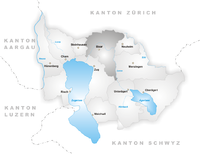Battle at Blickensdorf
| date | May 23, 1443 |
|---|---|
| place | Blickensdorf , Canton of Zug |
| output | draw |
| consequences | Battle of the Hirzel |
| Parties to the conflict | |
|---|---|
|
|
|
| Commander | |
|
|
|
| Troop strength | |
| unknown | unknown |
| losses | |
|
unknown |
unknown |
Etzel · Pfäffikon · Grüningen I · Freienbach · Blickensdorf · Hirzel · Bremgarten · Regensberg · Grüningen II · St. Jakob an der Sihl · Greifensee · St. Jakob an der Birs · Erlenbach I · Koblach · Sargans · Wil · Kirchberg · Wolfhalden · Obertoggenburg · Wigoltingen · Erlenbach II · Männedorf · Wollerau · Ragaz
The battle near Blickensdorf was fought on the night of May 23, 1443 in the course of the Old Zurich War near Blickensdorf (today's municipality of Baar ZG , Switzerland ).
The opponents were on the one hand the federal towns of Zug , Lucerne , Uri and Unterwalden and on the other hand troops from the imperial city of Zurich . The battle was the first military encounter between the four central Swiss locations in this war.
prehistory
After the armistice of December 1, 1440, Schwyz transmitted the declarations of war to the city of Zurich and Margrave Wilhelm von Hachberg on the night of May 20 to 21, on behalf of Austria. Glarus was warned to do the same. In the early morning of May 21st, the first acts of war of this second phase of the war took place, which were primarily directed against Rapperswil . At the first major encounter of the war on May 22nd, the advance of a Rapperswil contingent across Lake Zurich was rejected by the chiefs of Schwyz and Glarus in the battle of Freienbach . Zurich received a declaration of war from Lucerne on that day , and the declarations of war by Uri and Unterwalden should also have been made on that day. Bern and its ally Solothurn hesitated, and Zurich and the Habsburg captains believed they were strong enough at the time to take on the central Swiss troops.
course
The main contingent of the people of Zurich camped on the Albis , in anticipation of an attack there, but the Zurich leadership under Marshal Thuringia II of Hallwyl had to assign contingents to reinforce the Letzi on the Hirzel, since country people from the area around Horgen occupied them without orders from the leadership . The Zurich war plan provided for an attack on Zug territory, but there was insufficient information about the enemy strength. The mayor of Zurich, Rudolf Stüssi , who commanded the troops on the Albis, probably decided for this reason for a department to advance towards Zug. The main contingent of Zug was at Baar and was reinforced by the associations from Lucerne, Uri and Unterwalden.
The Zurich vanguard under Rudolf Stüssi advanced southward on the night of May 22nd to 23rd after midnight and encountered the enemy at Blickensdorf. The village was immediately set on fire by the people of Zurich, allegedly in retaliation for the robbery of two oxen in the Knonaueramt . At the beginning of the battle, the people of Zurich penetrated some of the enemy fortifications. After it became clear that a fight against the overpowering opponent was pointless, it was decided to withdraw. After a short battle, the Zurich team managed to break away from their opponents in order to retreat to the starting positions on the Albis. The Swiss then took up the pursuit, but the pursuit was broken off due to hunger and exhaustion near Kappel am Albis .
consequences
The meeting at Blickensdorf was a nighttime encounter that was broken off prematurely and had no decisive character. The result was that the Confederates were informed about the movements of the enemy, and the Zurich residents were also able to get an overview of the enemy strength. It was also one of the few battles of the entire war in which the Zurich side did not suffer defeat.
One day later, on May 24th, Schwyz and Glarus, whose main power was still in Freienbach , were warned by the troops from Lucerne, Uri and Unterwalden to move to the dam on the Hirzel , where they were camped nearby. Evidently provocations on the part of the defenders of the dam led to the Battle of the Hirzel , which took place on the same day , in which the people of Zurich and their allies were then completely put on the defensive by the associations of Lucerne, Uri and Unterwalden and ultimately forced to retreat to Zurich. so that the Zurich landscape lay more or less unprotected and could subsequently be devastated by the enemy.
See also
Web links
- Martin Illi: Old Zurich War. In: Historical Lexicon of Switzerland .
- Renato Morosoli: Blickensdorf. In: Historical Lexicon of Switzerland .
Individual evidence
- ↑ Alois Niederstätter: The Old Zurich War (1995)
